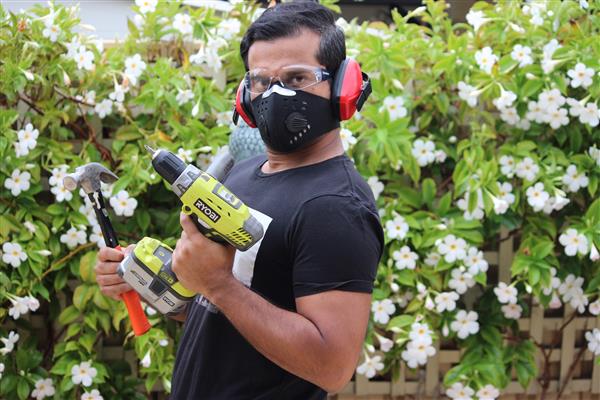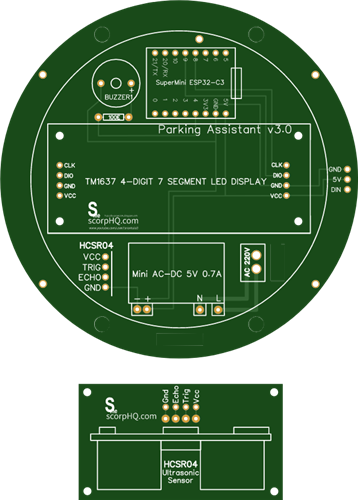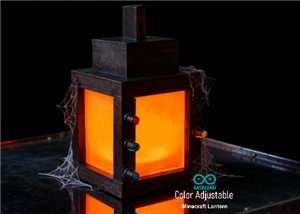|
|
18650 battery |
x 1 | |
|
|
TP4056UMW
|
x 1 | |
|
|
3D Printer |
x 1 | |
|
|
Humidifier Circuit |
x 1 |

|
Drill, Screwdriver |
Cute Medusa 3D Printed Humidifier
Humidifiers add moisture to the air. They can help people with dry skin, allergies, and respiratory problems. They may also help in preventing influenza and reduce snoring.
I bought this AU$2 USB Mini Humidifier DIY Kit from AliExpress and went ahead and created a cute little 3D container for it. In this tutorial, I will show you guys how I designed and assembled the humidifier circuit into the 3D model.
3D Model

While browsing the Internet, I found this cute little candle holder created by SERV3D on Cults3D.com. The design was very cute and I went ahead and upsized and customized the design to fit all my electronics bits into it.

With the help of Microsoft 3D Builder, I modified the 3D Model. The model has 2 compartments.
The top compartment is completely hollow to hold water in it. I kept the top section open to fill water into it.
All the electronics bits will go inside the second compartment. Those two screw holes are to hold the rechargeable 18650 battery holder.
This pipe like structure is for the wires to go from the top section to the bottom section.
The top compartment is 9.5cm x 4.5cm. So, if we calculate the volume of the cylinder it comes out to 604cm-cube. By dividing the volume by 1000 we can get the volume of water that can be stored inside that compartment. So, it comes out roughly around 0.6 liters.
At the back of the model, I created a grove to fit in a block of plastic that will house the TP4056 18650 battery charging module and a SPDT switch. The charging module gets super hot while charging, so I have given enough space in the block to keep the module cool.
The bottom lid will cover and hide all the electronics bits into it.
The top lid has a hole in the middle to house the humidifier straw.
Thats it as simple as that.
3D Printing

Once the 3D model was sorted, it was time for me to fire up my 3D printing oven and start printing these 3D models.
As we all know, 3D printing is the process that uses computer-aided design or CAD, to create objects layer by layer.
3D printing is not a new technology, its been there since the 1980's, when Charles W. Hull invented the process and created the first 3D-printed part. Since then, the field of 3D printing has grown exponentially and holds countless possibilities. The 3D printing process fascinates me a lot and I sometimes love to sit near my printer and watch these layers getting printed.
3D Printing is a highly addictive hobby! There are so many things you can do using a 3D printer. From designing 3D Models to printing them using the 3D printer has now become my new hobby. I've been a "maker" since I was 10 years old, and have always constructed and made my own stuff. 3D printing for me is a blessing. I am totally lost in the 3D printing heaven.

3D printing has changed my electronics workshop life forever. Before when I used to order parts, I always used to wonder if the parts would fit into my project's resources... but after I got my 3D printer... it doesn't matter at all, because if it doesn't fit - I could design and print it myself. The 3D printer was definitely "The Missing Piece" from my electronics workshop.

The entire printing process took roughly around 20hrs.
After extracting all the 3D printed bits, I sanded them to give them a nice and smooth texture.

This is the bottom cover, that's the top lid with a hole for the humidifier straw and a handle to open and close the lid. This block will hold the battery charger and the SPDT switch into it. The main body has the top compartment for holding water in it and the bottom compartment for housing all the electronics bits into it.
Schematic

The circuit is very simple.
By connecting an USB Type-C charging cable to the TP4056 Module we charge the 18650 battery connected to the B+ and B- terminals of the module. The humidifier module connects to the OUT+ and OUT- terminals of the charging module via a SPDT switch. Using this switch we can turn on or off the humidifier.
So, these are the components that were in the DIY Kit. A circular atomizer, two plastic holders, a straw and the main humidifier circuit board.
I customized the board by adding a couple of male pin headers to power this unit using a battery and dropped a blob of solder to bypass the push button switch.
To assemble, insert the atomizer into the black plastic holders along with the humidifier straw. Then connect the atomizer to the humidifier circuit board. In my project the circular atomizer will be way far from the circuit board. So, I will replace the short red and black cable with a long ribbon cable.
Assembling The Bottom

Let's start by soldering the battery holder to the B+ and B- terminals of the charging module. Then, let's solder the -ve connector that will power the humidifier to the OUT- terminal of the board. After that, let's solder a loose cable to the OUT+ terminal.
Now, let's slide the humidifiers +ve connector and the other end of the loose cable into the plastic block. Then, solder these two cables to the SPDT switch and superglue it to the block. Then push the charging module into the groves of the plastic block.
Once the block is all set, push it into the back of the main unit. After that, using a couple of screws attach the battery holder to the bottom of the unit. I used hot glue to stick the humidifier circuit to the bottom of the unit.
Once everything is in place, plug in the 18650 battery to the battery holder and push the white and black atomizers cable through the pipe like structure. After that, connect the atomizer's power chord to the humidifier and seal the bottom lid.
Assembling The Top

Be very careful while assembling the top. The atomizer has two sides.
The one with more exposed metal area, touches the humidifiers straw.
I soldered the atomizer to the white and black cable after passing it through the top lids hole. Then it was just a matter of putting the atomizer inside the two black holders along with the straw and then snap-closing it and pushing the setup through the hole.
That's it, all done.
Coloring

I wasn't very confident about PLA being waterproof and not absorbing water leading to swelling and degrading of the biodegradable plastic. So, I went ahead and painted the inner bit with "Bitumen Waterproofing Membrane".
Then, using Acrylic Colors, I painted the body of the 3D printed model. I gave the model a bit rustic look, but hey.. it totally depends on you how you want your project to look like.
Final Demo

To fill the container with water, you just need to lift the top lid and pour water into it.
Once fully charged, the unit can run seamlessly for roughly around 10 hours.
So, this is how my final setup looks like.
Do comment and let me know if there are any scopes of improvement.
Advantages
Dry air causes moisture to evaporate from the skin and respiratory symptoms to worsen over time. Adding moisture to the air with a humidifier can counteract these problems.
Humidifiers can help people who experience:
- cracked lips
- dry skin
- irritated eyes
- dryness in the throat or airways
- frequent coughs
- bloody noses
- allergies
- sinus headaches
Disadvantages
- Dirty humidifiers : If the unit’s water tank is dirty, the vapor a person breathes will also be dirty.
- Too much humidity : excessive level of humidity can make breathing difficult and some allergy symptoms worse.
- Using hard water or tap water : Minerals from hard tap water can build up in the machine, causing it to wear down faster than expected. The humidifier can also push these minerals into the air, and a person may inhale them.
Thanks
Thanks again for checking my post. I hope it helps you.
If you want to support me subscribe to my YouTube Channel: https://www.youtube.com/user/tarantula3
Video: View https://youtu.be/ffFAlr_vNPc
Full Blog Post: View https://diy-projects4u.blogspot.com/2024/11/3D-Medusa.html
References
GitHub: View https://github.com/tarantula3/3D-Medusa
Stl Files: Download https://github.com/tarantula3/3D-Medusa
Support My Work
BTC: 1Hrr83W2zu2hmDcmYqZMhgPQ71oLj5b7v5
LTC: LPh69qxUqaHKYuFPJVJsNQjpBHWK7hZ9TZ
DOGE: DEU2Wz3TK95119HMNZv2kpU7PkWbGNs9K3
ETH: 0xD64fb51C74E0206cB6702aB922C765c68B97dCD4
BAT: 0x9D9E77cA360b53cD89cc01dC37A5314C0113FFc3
LBC: bZ8ANEJFsd2MNFfpoxBhtFNPboh7PmD7M2
COS: bnb136ns6lfw4zs5hg4n85vdthaad7hq5m4gtkgf23 Memo: 572187879
BNB: 0xD64fb51C74E0206cB6702aB922C765c68B97dCD4
POL: 0xD64fb51C74E0206cB6702aB922C765c68B97dCD4
Thanks, ca again in my next tutorial.
Cute Medusa 3D Printed Humidifier
*PCBWay community is a sharing platform. We are not responsible for any design issues and parameter issues (board thickness, surface finish, etc.) you choose.
- Comments(6)
- Likes(2)
-
 (DIY) C64iSTANBUL
Nov 19,2024
(DIY) C64iSTANBUL
Nov 19,2024
-
 Ashish Adhikari
Nov 18,2024
Ashish Adhikari
Nov 18,2024
- 0 USER VOTES
- YOUR VOTE 0.00 0.00
- 1
- 2
- 3
- 4
- 5
- 6
- 7
- 8
- 9
- 10
- 1
- 2
- 3
- 4
- 5
- 6
- 7
- 8
- 9
- 10
- 1
- 2
- 3
- 4
- 5
- 6
- 7
- 8
- 9
- 10
- 1
- 2
- 3
- 4
- 5
- 6
- 7
- 8
- 9
- 10
 More by Ashish Adhikari
More by Ashish Adhikari
-
 Arduino Parking Assistant V3
The ESP32-C3 Based Parking Assistant is an advanced parking sensor system that utilizes the ESP32-C3...
Arduino Parking Assistant V3
The ESP32-C3 Based Parking Assistant is an advanced parking sensor system that utilizes the ESP32-C3...
-
 100 LED Chaser Circuit Using IC555 and CD4017
A Chaser Circuit consists of a clocked IC or other electronic unit like an Arduino that drives an ar...
100 LED Chaser Circuit Using IC555 and CD4017
A Chaser Circuit consists of a clocked IC or other electronic unit like an Arduino that drives an ar...
-
 Cute Medusa 3D Printed Humidifier
Humidifiers add moisture to the air. They can help people with dry skin, allergies, and respiratory ...
Cute Medusa 3D Printed Humidifier
Humidifiers add moisture to the air. They can help people with dry skin, allergies, and respiratory ...
-
 4x4x4 PCB LED CUBE
Note from PCBWay: This project includes two PCBs, if both need to be produced, please inform your sa...
4x4x4 PCB LED CUBE
Note from PCBWay: This project includes two PCBs, if both need to be produced, please inform your sa...
-
 Getting Started With Raspberry Pi Pico
Couple of months ago, I bought a "Raspberry Pi Pico" to get some hands-on experience of it and to cr...
Getting Started With Raspberry Pi Pico
Couple of months ago, I bought a "Raspberry Pi Pico" to get some hands-on experience of it and to cr...
-
 Make Your Own 3D Printed Diwali Diyas at Home
Diyas are the heart of major Indian festivals, most notably Diwali, the "Festival of Lights." Lighti...
Make Your Own 3D Printed Diwali Diyas at Home
Diyas are the heart of major Indian festivals, most notably Diwali, the "Festival of Lights." Lighti...
-
 Arduino Based 3D Printed Color Adjustable Minecraft Lantern
For this Halloween, I'm fusing the creative blocky world of Minecraft with the spooky glow of the co...
Arduino Based 3D Printed Color Adjustable Minecraft Lantern
For this Halloween, I'm fusing the creative blocky world of Minecraft with the spooky glow of the co...
-
 3D Printed Breathing IC555 LED Trophy
This project features a custom 3D-printed 'Mortal Kombat' trophy shell paired with a basic NE555 tim...
3D Printed Breathing IC555 LED Trophy
This project features a custom 3D-printed 'Mortal Kombat' trophy shell paired with a basic NE555 tim...
-
 Destiny Internet Ghost - Internet Notifier
The Internet has changed the way we live our lives. From communication, education, banking, entertai...
Destiny Internet Ghost - Internet Notifier
The Internet has changed the way we live our lives. From communication, education, banking, entertai...
-
 Liquid level indicator Using ULN2003
A water level indicator detects and indicates the level of water in an overhead tank and relays the ...
Liquid level indicator Using ULN2003
A water level indicator detects and indicates the level of water in an overhead tank and relays the ...
-
 All About IC UNL2003
The UNL2003 IC contains 7 High Voltage, High Current NPN Darlington Transistor Arrays each rated at ...
All About IC UNL2003
The UNL2003 IC contains 7 High Voltage, High Current NPN Darlington Transistor Arrays each rated at ...
-
 NodeMCU Based: 3D Printed Indoor Gauge Thermometer
Had some time this weekend and a desire to create something new and interesting, so went ahead and c...
NodeMCU Based: 3D Printed Indoor Gauge Thermometer
Had some time this weekend and a desire to create something new and interesting, so went ahead and c...
-
 Rechargeable Gothic Lantern
A Gothic Lantern is a captivating piece of lighting that brings the allure of the Victorian Era into...
Rechargeable Gothic Lantern
A Gothic Lantern is a captivating piece of lighting that brings the allure of the Victorian Era into...
-
 555 Adjustable Delay On Off Timer Circuit
The 555 timer IC is an integrated circuit (IC) that is used in a variety of timer, delay, pulse gene...
555 Adjustable Delay On Off Timer Circuit
The 555 timer IC is an integrated circuit (IC) that is used in a variety of timer, delay, pulse gene...
-
 3D Printed Arduino Halloween Décor
When the full moon is shining and the wolves are howling, it's time for Halloween's spooky spectacle...
3D Printed Arduino Halloween Décor
When the full moon is shining and the wolves are howling, it's time for Halloween's spooky spectacle...
-
 All About RCWL-0516 Microwave Radar Motion Sensor
Proximity sensing is a very common application in electronics.There are several ways to accomplish t...
All About RCWL-0516 Microwave Radar Motion Sensor
Proximity sensing is a very common application in electronics.There are several ways to accomplish t...
-
 Transformers PCB BADGE
It's been a while, the Autobots have appeared on the silver screen. Finally they are returning to th...
Transformers PCB BADGE
It's been a while, the Autobots have appeared on the silver screen. Finally they are returning to th...
-
 LED Fader Using 555 Timer IC
LED Fader Using 555 Timer ICWanted to generate a LED fading effect (fade-in and fade-out) for my upc...
LED Fader Using 555 Timer IC
LED Fader Using 555 Timer ICWanted to generate a LED fading effect (fade-in and fade-out) for my upc...
-
-
mammoth-3D SLM Voron Toolhead – Manual Drill & Tap Edition
140 0 0 -
-
AEL-2011 Power Supply Module
653 0 2 -
AEL-2011 50W Power Amplifier
567 0 2 -
-
-
Custom Mechanical Keyboard
769 0 0 -
Tester for Touch Screen Digitizer without using microcontroller
395 2 2 -
Audio reactive glow LED wristband/bracelet with NFC / RFID-Tags
363 0 1 -
-











































